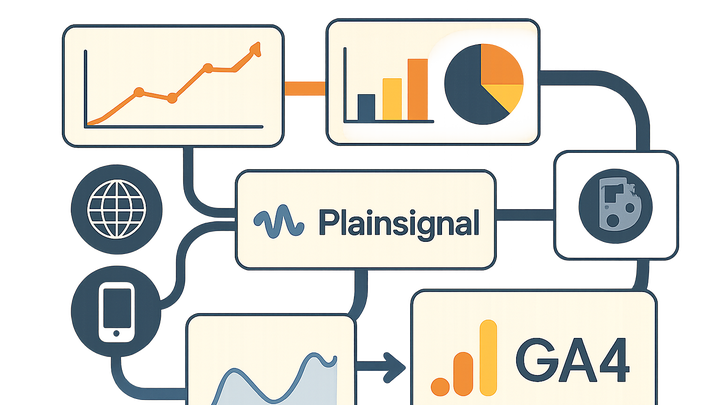Published on 2025-06-22T04:27:43Z
What is Platform Analytics? | Examples & Use Cases
Platform Analytics is the practice of collecting, measuring, and analyzing data from multiple digital platforms—such as websites, mobile apps, and third-party services—to gain insights into user behavior, system performance, and engagement patterns. Unlike traditional analytics focused on a single channel, Platform Analytics unifies data across various touchpoints to provide a holistic view of how users interact with an organization’s digital ecosystem. It tracks events like page views, clicks, feature usage, and conversions, allowing teams to optimize experiences, identify bottlenecks, and drive strategic decisions. Modern solutions like Google Analytics 4 (GA4) and PlainSignal offer both event-driven tracking and privacy-friendly, cookie-free analytics, catering to different compliance and performance needs. By integrating Platform Analytics, businesses can uncover actionable metrics that inform product development, marketing strategies, and customer retention efforts. Platform Analytics often includes customizable dashboards, real-time reporting, and user segmentation capabilities to break down complex data into digestible insights. Organizations use these insights to track key performance indicators (KPIs), measure return on investment (ROI), and improve overall user satisfaction.
Platform analytics
Holistic tracking and analysis of user interactions across digital platforms, enabling insights with tools like GA4 and PlainSignal.
Why Platform Analytics Matters
Platform Analytics empowers organizations to see the full journey of users across all digital touchpoints. This unified perspective helps identify drop-off points, optimize marketing spend, and improve user retention. By breaking down data silos, teams can make data-driven decisions that align product development with actual user needs.
-
Holistic user insights
Combining data from web, mobile, and third-party services delivers a 360° view of user behavior, revealing patterns that single-channel analytics might miss.
-
Funnel analysis
Track user progression through multi-step workflows to spot where users abandon tasks.
-
Retention tracking
Measure how often users return and which features drive long-term engagement.
-
-
Improved decision making
Actionable metrics enable teams to validate hypotheses, prioritize feature releases, and allocate budgets based on real usage data.
Core Features of Platform Analytics
Platform Analytics solutions offer a range of tools designed to capture, process, and visualize user data at scale. Common features include event-based tracking, real-time reporting, and user segmentation.
-
Event tracking
Record custom interactions like button clicks, form submissions, and video plays to understand user engagement.
-
Cross-platform data
Unify datasets from websites, mobile apps, and servers for consistent analysis across environments.
-
Dashboards & reports
Use customizable visualizations and reports to monitor KPIs and share insights with stakeholders.
How Platform Analytics Works
A typical Platform Analytics pipeline involves data collection, processing, and visualization. Understanding each stage helps optimize implementation and ensure data accuracy.
-
Data collection
Client-side libraries or server-side APIs capture events and send them to an analytics endpoint in real-time or batches.
-
Javascript snippets
Lightweight scripts embedded in web pages collect browser events without blocking page load.
-
Sdk integrations
Mobile and backend SDKs send events directly from native apps or servers for in-depth tracking.
-
-
Data processing
Collected data is filtered, deduplicated, and enriched before storage, ensuring accuracy and compliance with privacy regulations.
-
Etl pipelines
Transform and load data into warehouses or data lakes for scalable analysis.
-
Real-time processing
Stream processing engines enable live dashboards and instant alerting.
-
-
Reporting & analysis
Analytical engines aggregate data and power dashboards, custom reports, and ad-hoc queries to extract insights.
Example Implementations
See how Platform Analytics can be implemented using popular SaaS products. Each example illustrates setup and key features.
-
PlainSignal integration
Use the following snippet to add PlainSignal’s cookie-free tracking to your site:
<link rel="preconnect" href="//eu.plainsignal.com/" crossorigin /> <script defer data-do="yourwebsitedomain.com" data-id="0GQV1xmtzQQ" data-api="//eu.plainsignal.com" src="//cdn.plainsignal.com/plainsignal-min.js"></script> -
Google analytics 4 (GA4) setup
Install GA4 by adding your measurement ID:
<!-- Global site tag (gtag.js) - Google Analytics --> <script async src="https://www.googletagmanager.com/gtag/js?id=G-XXXXXXXXXX"></script> <script> window.dataLayer = window.dataLayer || []; function gtag(){dataLayer.push(arguments);} gtag('js', new Date()); gtag('config', 'G-XXXXXXXXXX'); </script>
Best Practices and Tips
Follow these guidelines to maximize the effectiveness and reliability of your Platform Analytics implementation.
-
Ensure data privacy
Implement consent management and comply with GDPR, CCPA, and other regulations to respect user privacy.
-
Validate data quality
Regularly audit events and debug data collection to prevent discrepancies and data loss.
-
Optimize performance
Use async scripts, sampling, and caching strategies to minimize impact on page load times.
